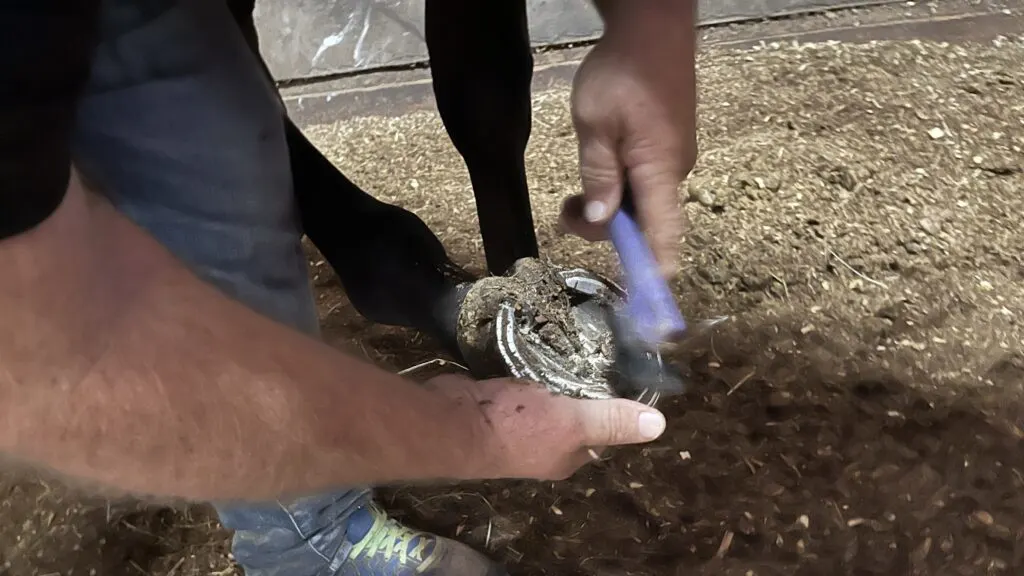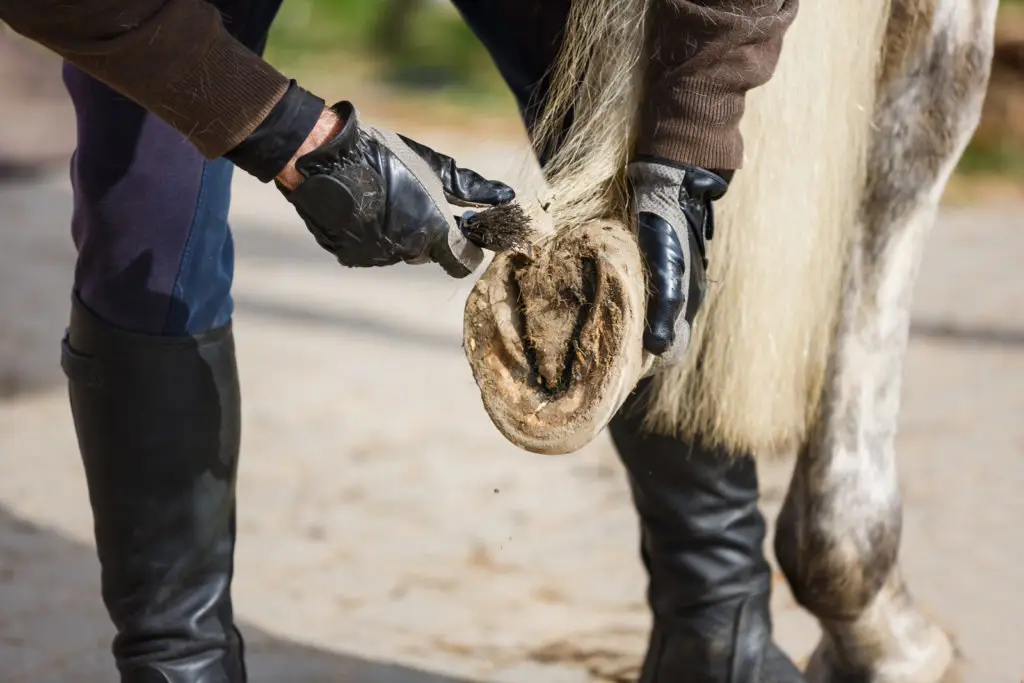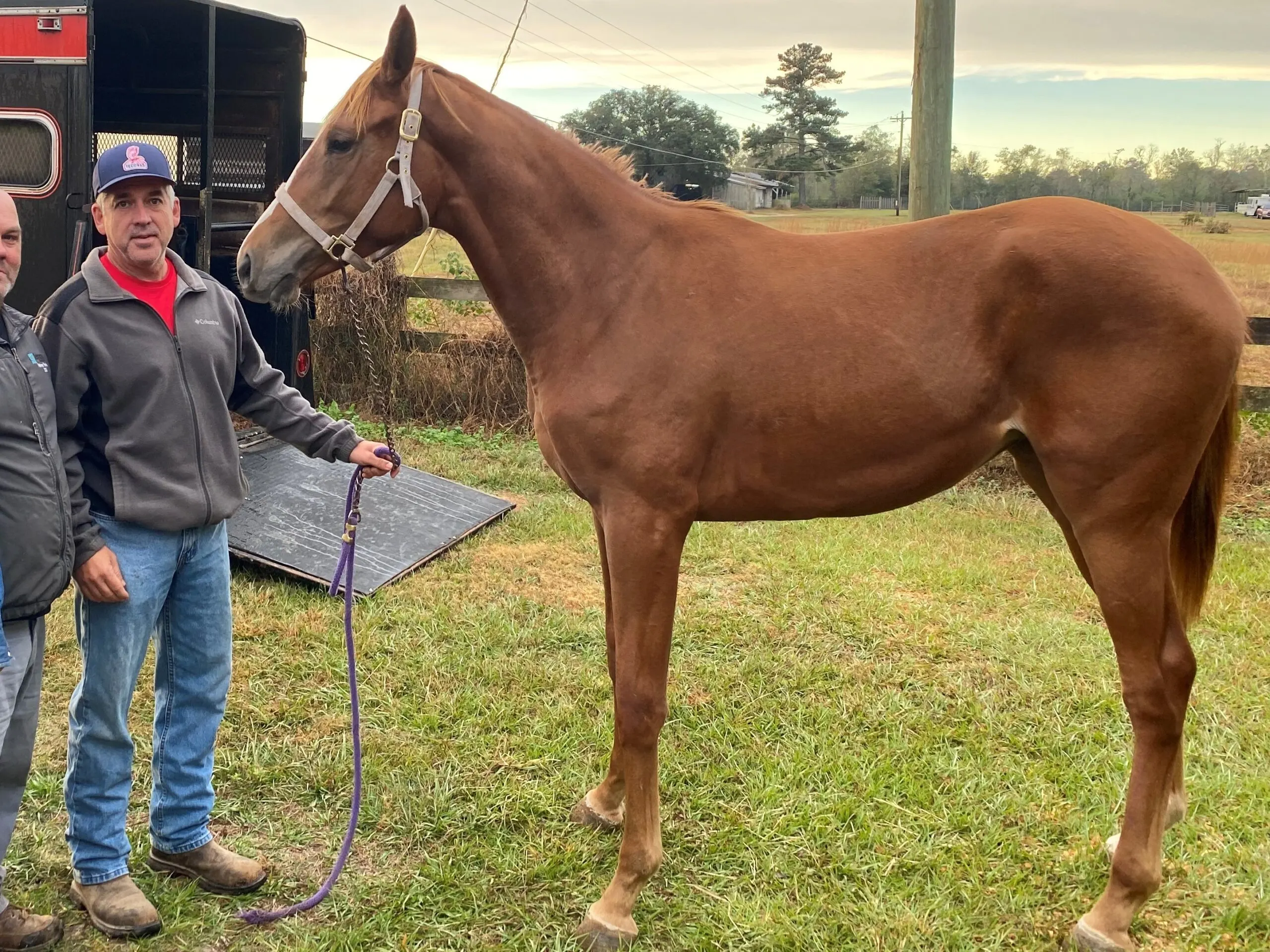Last updated: April 24, 2023
Any links on this page that lead to products on Amazon are affiliate links and I earn a commission if you make a purchase. Thanks in advance – I really appreciate it!
When our neighbor’s horse developed an abscess before his futurity trial, he was forced to scratch from the race. This marked the third time the horse missed running due to foot infections, leaving the owner questioning why his horse kept developing abscesses.
Horses commonly get abscesses from sole bruising, hoof cracks, or puncture wounds. Recurring abscesses often result from bacteria infiltrating weakened hooves, with horses having poor hoof quality being more susceptible. Unsanitary, damp stall conditions can also contribute to bacterial growth.
Abscesses are a frequent issue in horses, but most recover swiftly. Owners of horses with recurrent abscesses should take extra precautions, such as maintaining proper hoof care and providing clean, dry living conditions, to minimize the risk of future infections. Learn more about abscesses, their causes, and prevention strategies in this article.
What is an abscess?

An abscess is a bacterial infection that occurs within a horse’s foot, forming pockets that fill with pus, typically beneath the sole and inside the hoof wall. Many abscesses tend to work their way up and eventually rupture near the coronary band, which is the junction between the horse’s hoof and the skin of the leg.
While abscesses can be painful, they are often minor issues that heal independently or with routine hoof trimming. Mild abscesses can be likened to bruises or blisters in humans. For example, I had a board drop on my finger, causing a blood vessel to rupture under my nail.
As fluid accumulated over a couple of days, I experienced excruciating, throbbing pain. Drilling a hole through the nail released the blood, providing instant relief and allowing for quick healing. Similarly, a minor horse abscess might require a farrier to cut a drain hole in the sole to alleviate pressure and pain.
Below is a YouTube video about abscesses in horse hoofs.
Horse owners and trainers sometimes overlook proper foot care while focusing on training and diet. Neglecting foot care can lead to recurring abscesses, which, if left untreated, can develop into serious health issues.
Common Causes of Abscesses
Horses can develop an abscess for various reasons. One common cause is sole bruising. Imagine walking around with a big rock in your shoe. That’s how a horse feels when its sole gets bruised. This can cause an abscess to form because the bruise can make it easier for bacteria to enter the hoof. Hoof cracks can also lead to abscesses since they create openings for bacteria to sneak in.
Sometimes, a horse might step on a sharp object, like a nail or a piece of glass. This can create a puncture wound, which is another way for bacteria to get inside the hoof and cause an abscess. Bacterial infections in the hoof can lead to abscesses, too, especially if the horse’s immune system is weak.
Finally, poor foot care and unhygienic stall conditions can also cause abscesses. If a horse’s hooves are not cleaned and maintained regularly, dirt and bacteria can accumulate, increasing the chances of an abscess forming. Also, if a horse’s stall is always wet and dirty, it can weaken the hooves and make it easier for bacteria to cause an infection. So, keeping your horse’s hooves clean and its living area tidy can help prevent abscesses from forming
I wrote a helpful article on how to care for your horse’s hooves; you can read it here: How to Care for and Clean Horses Hooves: 6 Essential Steps.

Hoof cracks
Hoof cracks are quite common in horses, and their causes and severity can differ. Racehorses, in particular, tend to have more hoof cracks than other horses. This might be because Thoroughbreds are known for having weaker feet, they put a lot of pressure on their hooves during races, and they usually wear shoes. Thankfully, most hoof cracks are just cosmetic and don’t pose any health risks. However, even small cracks can allow bacteria to enter and cause an infection.
To prevent hoof cracks, it’s essential to keep your horse’s feet well-trimmed. Long toes can put extra pressure on the hoof wall and lead to cracks. If your horse constantly suffers from cracked hooves, it’s a good idea to consult your farrier or veterinarian for advice and proper treatment.
Some horse owners, like me, use hoof conditioners to strengthen the hoof walls and add biotin supplements to their horses’ diets. I have been doing this for years and believe these products help keep my horses’ hooves healthy and strong.

Puncture wounds
Puncture wounds often happen on the sensitive sole of a horse’s hoof, which is the underside of the foot. These injuries can range from minor to very serious. Horses might step on sharp objects like nails, screws, or wires, causing puncture wounds. However, the most common cause is misplaced horseshoe nails.
When a puncture wound is superficial, it can lead to an infection and form an abscess. If you think your horse has a puncture wound, inspect its foot, remove the object, clean the area, and apply a poultice. This treatment usually works for simple puncture wounds. If an infection develops, drain the pus and apply another poultice.
Keep an eye on your horse; if it becomes lame in the next few days, call your vet for an evaluation. It’s especially important to contact your vet if the puncture is in the back half of the foot or involves the frog. Luckily, superficial puncture wounds typically heal without any complications.

Weak hoof walls
Weak hoof walls are a common issue in Thoroughbreds, often because they’re bred for speed without considering the quality of their feet. Many have thin hoof walls that allow bacteria to enter and cause abscesses. Since racehorses spend a lot of time in stalls, wet stall floors can also lead to bacterial infections in their hooves.
A horse’s performance can be significantly affected by abscesses, regardless of its speed. One trainer had a horse that won nearly $100,000 in its first two races but then suddenly started slowing down during races. After being sold in a cheap claiming race, the new trainer discovered the horse’s abscess issues. The abscesses weren’t obvious, but the horse frequently developed them. To resolve the problem, the trainer ensured the horse’s feet were always dry and clean, leading to a successful turnaround in the horse’s performance.
Supplements with biotin strengthen horses’ hooves. Also, make sure to keep your horse moving. Blood flow is critical for the health of horses’ feet. Amazon sells some hoof supplements; I typically stick with brands I know, like Farnam, but I haven’t found one brand significantly better than others.
Other factors
There are several other factors that may predispose horses to develop abscesses, although they are less common. These include:
- Temperature: Cold weather can cause hooves to become thinner and more susceptible to bacterial infections.
- Sole bruising: Horses with chronic inflammation in their hooves or lower legs may rock back and forth, leading to sole bruising and potentially causing abscesses.
- Chronic inflammation: This can result in increased pressure on the hooves, causing the horse to develop abscesses.
- Cushing’s disease: This hormonal disorder weakens the horse’s immune system, making them more prone to bacterial infections and abscess formation.
If your horse experiences recurring abscesses, consider these factors and consult with a veterinarian or farrier to determine the best course of action for maintaining your horse’s hoof health.

Signs and Symptoms of Abscesses
When a horse has an abscess, there are some clear signs and symptoms that can help you identify the problem. It’s essential to recognize these signs so that you can take action and help your horse feel better.
A. Limping or lameness
One of the first things you might notice is that your horse starts limping or showing signs of lameness. This happens because the abscess causes pain and discomfort in the hoof, making it difficult for the horse to walk normally. If you see your horse limping or not wanting to put weight on one of its hooves, it might be a sign that an abscess is present.
B. Heat and swelling in the hoof
Another sign of an abscess is heat and swelling in the hoof. When you touch the hoof, it might feel warmer than usual, and you may notice some swelling around the area. This is because the body is trying to fight off the infection, which leads to increased blood flow and inflammation in the affected area.
C. Sensitivity to hoof testers
Finally, your horse might show sensitivity when a hoof tester is applied. A hoof tester is a tool used by farriers and veterinarians to gently squeeze different parts of the hoof to check for pain or discomfort. If your horse reacts strongly when the hoof tester is applied to a particular area, it could indicate an abscess. If you notice any of these signs and symptoms, it’s essential to consult with a veterinarian or farrier to get a proper diagnosis and treatment plan for your horse.
Treating and Preventing Abscesses
Taking care of your horse’s hooves is essential to prevent and treat abscesses. Here are some important steps you can follow to help your horse stay healthy and happy.
Farrier intervention and hoof trimming
First, make sure to have a farrier regularly check and trim your horse’s hooves. Farriers are professionals who specialize in caring for horses’ feet. They can identify any problems, like cracks or bruises, and trim the hooves to keep them in good shape. Regular hoof trimming can prevent many issues, including abscesses, by keeping the hooves strong and balanced.
Drainage and relief of pressure
If your horse has an abscess, it might need help to drain the pus and relieve the pressure. A farrier or veterinarian can carefully cut a small hole in the hoof to let the pus drain out. This process can provide immediate relief for your horse and help the abscess heal faster. It’s essential to keep the area clean and dry after drainage to prevent further infection. Drawing salve can also be applied to a horse’s foot to help draw out the pus and promote healing.
Regular hoof care and maintenance
To prevent abscesses, it’s crucial to practice regular hoof care and maintenance. This includes picking out your horse’s hooves daily to remove dirt, rocks, and debris. Also, check for any signs of injury or infection. Keep your horse’s stall clean and dry to prevent bacteria from thriving in a moist environment. Additionally, providing your horse with a balanced diet and proper supplements can help promote strong, healthy hooves.
By following these steps, you can help prevent and treat abscesses in your horse’s hooves. Remember, healthy hooves are essential for a happy and active horse, so always pay attention to their needs and care.

Importance of Proper Foot Care
Taking good care of your horse’s feet is crucial for their overall health and happiness. One important step in foot care is regularly inspecting and cleaning your horse’s hooves. This means checking their feet every day for dirt, rocks, and other debris that might get stuck in the hoof.
Use a hoof pick to gently remove any trapped dirt or objects. By doing this daily, you can spot any problems, like cracks or injuries, early on and get them treated before they become severe. Another essential aspect of foot care is ensuring your horse has proper shoeing and trimming.
Work with a skilled farrier who knows how to trim and balance your horse’s hooves correctly. Properly trimmed and balanced hooves can prevent many issues, including abscesses and lameness. If your horse wears shoes, make sure they fit well and are replaced as needed to maintain healthy hooves.
Sometimes, a horse may have underlying hoof issues that need attention. These can include weak hoof walls, cracks, or even infections. By working closely with your farrier and veterinarian, you can identify and treat these problems to help your horse maintain healthy feet. This might involve using special hoof care products, adjusting your horse’s diet, or even treating an infection with medication.
Conclusion
Abscesses are a common issue in horses that can cause discomfort and, in severe cases, lead to more significant health problems. Understanding the primary causes of abscesses, such as sole bruising, hoof cracks, puncture wounds, and poor foot care, is crucial in preventing and treating them effectively.
By maintaining proper hoof hygiene, ensuring dry and clean stall conditions, and working closely with a qualified farrier or veterinarian, horse owners can minimize the risk of abscess formation and ensure their equine companions stay healthy and happy.
Remember, a horse’s hooves are a vital part of its overall well-being. Taking the necessary precautions to protect them will contribute to a more successful and enjoyable partnership with your horse.

Some horses have genetically bad feet and are susceptible to developing abscesses. The best way to prevent recurrent abscesses is to keep your horses’ hooves clean and dry.
FAQs
How to get a hoof abscess to burst
To encourage a hoof abscess to burst, first, consult your veterinarian or farrier. They may suggest using a warm Epsom salt soak, applying a drawing salve, or wrapping the hoof with a poultice to help draw out the pus. Keep the hoof clean and dry, and monitor your horse’s progress closely. Never attempt to cut or puncture the abscess yourself.
Should a horse with an abscess be on stall rest?
A horse with an abscess should be kept comfortable, which may include stall rest or limited turnout, depending on the severity of the abscess and your veterinarian’s recommendations. While some movement may help promote drainage, excessive exercise can worsen the condition. Always consult with your veterinarian for the most appropriate care plan for your horse’s specific situation.
Related articles
- Cleaning Hoofs, Leads to a Healthier Horse
- Why Do Horses Trip and Stumble So Much? 7 Reasons
- Horseshoes: Why Horses Need Them Plus Facts, Uses, and Types
Meet Miles Henry
An avid equestrian and seasoned racehorse owner, Miles Henry brings his extensive experience to the equine world, proudly associating with the AQHA, The Jockey Club, and various other equine organizations. Beyond the racetrack, Miles is an accomplished author, having published various books about horses, and is a recognized authority in the field, with his work cited in multiple publications.
🔗 Connect with Miles:
Twitter
Facebook
YouTube: Check out race highlights, horse care tips, and more!

